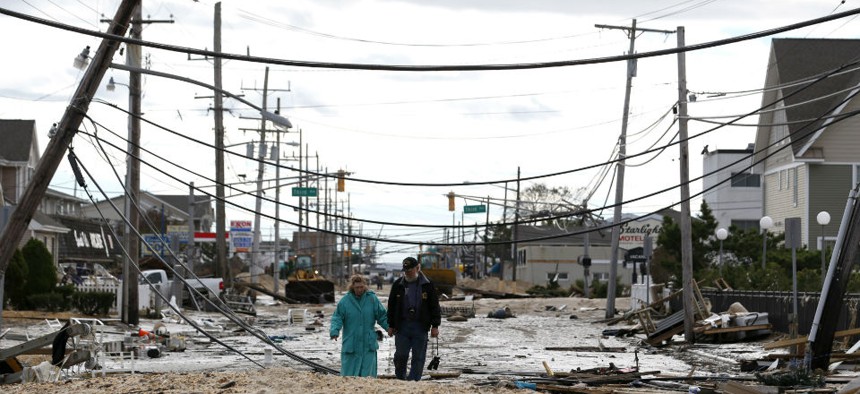Senators Press for Flood Insurance Fraud Probe
FEMA and SBA faulted for mishandling Hurricane Sandy aid.
The Federal Emergency Management Agency failed to follow up on indicators that insurance companies altered damage assessments to avoid payouts to victims of Hurricane Sandy in 2012, according to news reports, court records and senators from New York and New Jersey.
As detailed Sunday night in a “60 Minutes” broadcast, FEMA 18 months ago had been made aware of complaints by homeowners that engineers’ reports showing structural damage to their homes from the superstorm were reworked by engineering and insurance companies in the National Flood Insurance Program.
On Monday, four Democratic senators -- Bob Menendez and Cory Booker from New Jersey, and Kirsten Gillibrand and Chuck Schumer from New York -- demanded hearings on the topic at the Banking, Housing and Urban Affairs Committee. They cited “serious concerns about when FEMA learned of the potential fraud, what steps FEMA took to address it, and FEMA’s general oversight of those that run the NFIP program on its behalf.”
They spoke the same day the inspector general for the Small Business Administration issued a report saying SBA had issued nearly $18 million in loans to victims of Sandy without sufficiently considering principals’ living expenses when determining repayment ability.
On the CBS broadcast, Brad Kieserman, who has headed the flood insurance program for just three weeks, acknowledged that FEMA had first heard “signals” of fraud by insurance companies in August 2013, and that he had referred the problem to the Homeland Security Department inspector general.
“It is shocking to us that FEMA officials received specific allegations of fraudulent activity that served as the basis for claimants being denied the coverage they had paid for, including homeowners who lost their homes, and either did not appropriately investigate these claims or simply looked the other way,” the senators wrote in their letter to Banking Committee leaders. Despite a July 2014 promise from FEMA Administrator Craig Fugate to investigate, they added, no probe was launched until December.
The senators also reacted to a Feb. 18 raid on the office of one engineering firm alleged to have altered damage assessments in order to lower payouts by investigators from the New York State Attorney General’s office.
These “serious allegations and the questions that they raise are highly troubling” given that more than 1,000 property owners have lawsuits pending in the U.S. Eastern District of New York against insurers over claims that were denied in the wake of Sandy, the senators said.
In one case cited from court records, Eastern District Magistrate Judge Gary Brown, after hearing a case by a Long Beach, N.J., woman that appeared to involve altering of an assessment by an engineering firm, ruled that all drafts of engineering reports be shown to the court, a requirement that FEMA initially appealed. Fugate later withdrew the appeal.
Homeland Security Secretary Jeh Johnson on Monday issued a statement saying FEMA is fully cooperating and has set up an interim office of the “Flood Insurance Advocate to ensure policyholders and property owners are treated fairly throughout the process of mapping flood hazards, the identification of risks from flood and the implementation of measures to minimize flood damage.” He said he and Fugate were concerned by revelations in the “60 Minutes” report. “We share the views expressed by FEMA Deputy Associate Administrator Brad Kieserman during the program. Any allegation of fraud is highly troubling, and especially so when it involves Americans who have lost their homes in a natural disaster,” Johnson said.
Also on Monday, the SBA watchdog’s report described a review of 2,532 approved Hurricane Sandy business loans as of July 29, 2014, totaling some $234.4 million. A sampling of 70 loan files along with interviews with SBA officials showed that standard operating procedures included no guidance for analyzing the borrowers’ ability to repay, which significantly raised the risk of default. “Because there was no guidance, loan officers used inconsistent methodologies when evaluating Hurricane Sandy business loans for repayment ability,” the report said. “We estimate that SBA approved at least 537 Hurricane Sandy disaster business loans, totaling at least $17.9 million, without sufficiently considering principals’ living expenses when determining repayment ability.”
The IG recommended that SBA “establish and implement clear, written policies and procedures for analyzing the repayment ability of disaster business loan applicants, including business loan principals and guarantors.” Agency managers generally accepted the recommendations, though they challenged the projection of $17.9 million in risky loans.




